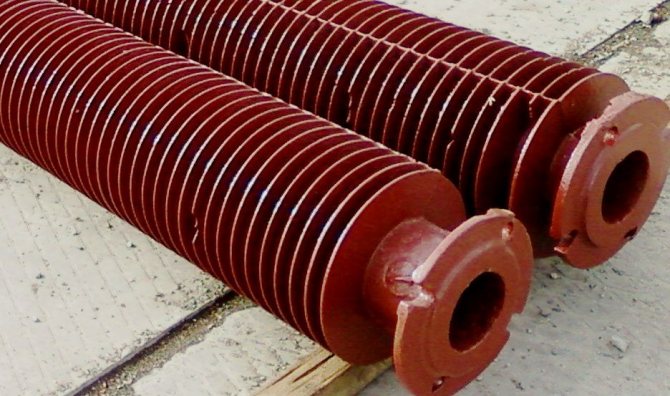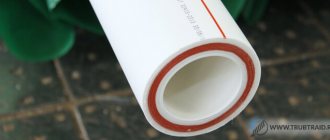The finned tubes are equipped with metal fins, due to which their outer surface is increased. This leads to an increase in the efficiency of heat transfer by one and a half times. Ribbed products are used in industry and in everyday life. They are used to equip heat exchangers and coolers, heating systems, industrial refrigerating chambers, metal communications.
Finned tubes - products with special properties and characteristics
A few words about the design
Pipes with metal fins do not differ in terms of the overall structure, but the differences lie in the details - the shape of the petals and the ribbing coefficient.
The pipe consists of two parts.
- The foundation. It is the pipe itself, which was made using anti-corrosion materials. The pipe must cope with pressure and sudden temperature changes. In the manufacture of pipes, three types of materials are used - steel, cast iron and non-ferrous metal.
Important! Depending on the tasks, either a refrigerant or a heat carrier is allowed through the pipes.
- Ribs. They are attached to the base. Since the entire surface of the petals is heated, the efficiency of the pipe remains equally high, regardless of the temperature of the coolant.
Interesting! Ratio of ribbing = area of ridges + area of areas between them / non-ribbed surface. The higher the ratio, the higher the efficiency.

During the production process, cast iron pipes are cast immediately with ribs. When working with other materials, the following tricks apply:
- crimping washers;
- high-frequency welding of elements;
- electric arc and resistance welding;
- cross-helical knurling;
- winding with tension of a metal tape on the base.
Interesting! Ribs with slots can sometimes be found. The slots also ensure efficient operation of the pipe.
Pipes made by rolling aluminum can withstand temperatures up to 350 ⁰C, while pipes made by winding a steel strip onto a base can withstand higher rates.


Services for the installation of heating water supply
DESIGN PRESTIGE LLC 8 (495) 744-67-74
In addition to fast and high-quality repair of heating pipes, we provide professional installation of turnkey heating systems. On our page by topic heating > resant.ru/otoplenie-doma.html For communication, use the contact phone number of DESIGN PRESTIGE LLC 8(495) 744-67-74, which you can call around the clock. note Our company DESIGN PRESTIGE LLC is a part of the non-profit organization ANO INTERREGIONAL COLLEGE OF JUDICIAL EXPERTS. We also provide services for independent construction technical expertise. Pipes with a heat-resistant layer coated with magnesium oxide have the following advantages: Due to these important advantages, heat-resistant finned pipes have the following advantages. Cast iron batteries have a number of significant advantages that make them the most optimal option when designing a heating system.The list of the main advantages of finned tubes made of this heavy-duty material is as follows: Finned tubes are extremely popular today. They can be seen wherever a room needs to be either heated or cooled. As we mentioned earlier, the efficiency of finned tubes is based on the high heat transfer achieved by the design features. Finned tubes are part of many devices in private homes and factories. In the first case, they are used in air conditioners, since they help in air cooling as much as possible. In the second case, they are used not only for cooling, but also for heating the room, and also help in getting rid of aggressive gases and liquids. The most popular area of production where finned tubes can be found is mechanical engineering. There they are used in the manufacturing process of various devices: Even after the appearance of an alternative in the form of bimetallic or aluminum sections, cast iron radiators have not lost their fans. Most likely, this lies in their technical characteristics, which were able to prove to everyone that cast iron heating devices meet all the requirements. We believe that they should be told in more detail: Cheboksary cast-iron heating radiators in modern design Advice: cast iron radiators can withstand temperatures up to 150 ° C, and therefore can be used in a steam heating system. Additional benefits: Another option for a heating radiator is a ribbed cast iron pipe Among the shortcomings, the following should be noted: In the photo - the overall dimensions of the chm2 products Before sending to the store for a cast iron radiator, you must consider some technical criteria: Heating cast iron radiators (China) To calculate the heat output of a cast-iron battery for each individual room, use the following rule: Battery "Breeze" meets all quality standards We also recommend paying attention to the following factors: Tip: you can calculate the number of required sections by dividing the total required power for heating the room by the power of one section. The instruction recommends installing radiators under each window in the room. So you will be able to significantly reduce heat loss. Standard dimensions of cast iron radiators: The assembly of cast iron heating radiators is carried out using a special key It is becoming more and more difficult for manufacturers to sell old models, so today the market is trying to capture the buyer with the originality of the design. Most of us, when we mention cast iron radiators, immediately associate with something rude and unaesthetic. Therefore, the designers and designers decided to breathe new fresh solutions into the product: Companies from many countries are represented on our market, including Germany, Great Britain, China, Czech Republic, Turkey, Italy and Spain.Their difference from domestic products is higher quality and aesthetic surfaces. In addition, the thermal power of the device remains the same, but its dimensions are significantly reduced. Model range of radiators with legs made of cast iron Retro (Turkey) For example, a Czech radiator holds 800 ml of coolant in a section, while a Russian classic MC-140 has 1.3 liters. So with the same heat transfer, the foreign version will be more compact and lighter. The inner surface of foreign radiators is almost perfectly smooth, and this helps to reduce the resistance to the movement of the coolant and prevents the formation of scale layers on the walls of the battery. Also, imported options are offered already painted, while domestic ones need painting after installation. One of the disadvantages of imported products is the high cost of models, which significantly exceeds the cost of domestic samples. When making pipes with finning on your own, it is imperative to take into account the decrease in the efficiency of the "handicraft" pipe in comparison with factory samples. Finning a pipe at home can be done in the following ways:Heating from DESIGN PRESTIGE LLC Type: hot water here> resant.ru/otoplenie-dachi.html
Heating of a private house:
Advantages of finned tubes


System advantages
A little about the scope


Distinctive feature
Rust resistant Cast iron is not susceptible to corrosion, which is an important property, especially when the system is drained in summer. Durability A very important product advantage. If you follow all the rules of operation, including regular preventive maintenance, cast-iron batteries for heating a house can stand without repair for almost half a century. Coolant quality Alas, in centralized heating systems, the water quality is poor. It contains various chemical compounds, rust particles, alkali and others, to which the internal surfaces of the radiator do not react. In addition, it is not so easy to scratch and dissolve cast iron. Clogging Wide channels ensure normal circulation of the coolant. Therefore, even if there are foreign objects or deposits in the system, this will not be a problem. Storage capacity Cast iron products are very thermally inert. They take it for a long time, but then they give it up for a long time if the system is turned off. For example, after an hour, the heat transfer will be 30%. If the heat supply is periodically cut off, the batteries will be able to smooth out its short-term absence. 



How to choose






Modern tendencies
What to choose - domestic model or foreign


Do-it-yourself pipe finning - how to achieve this




















